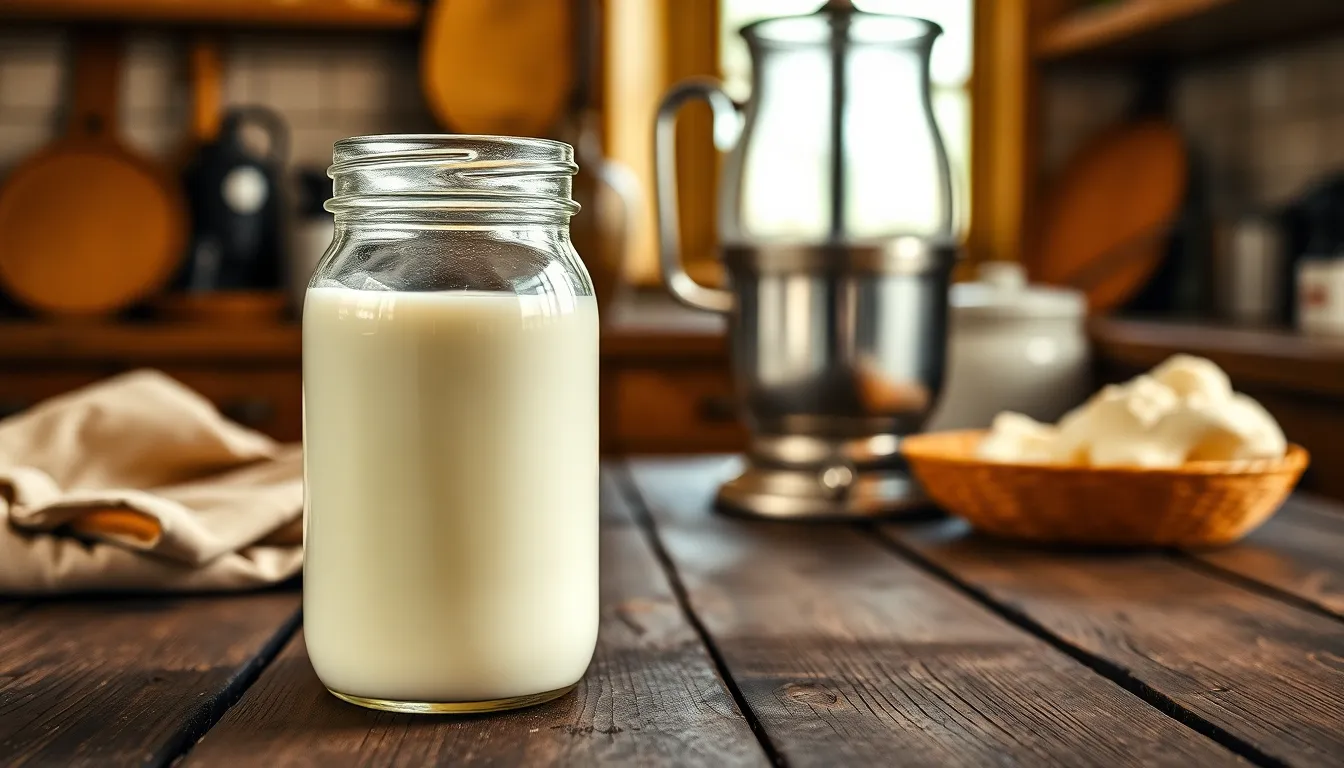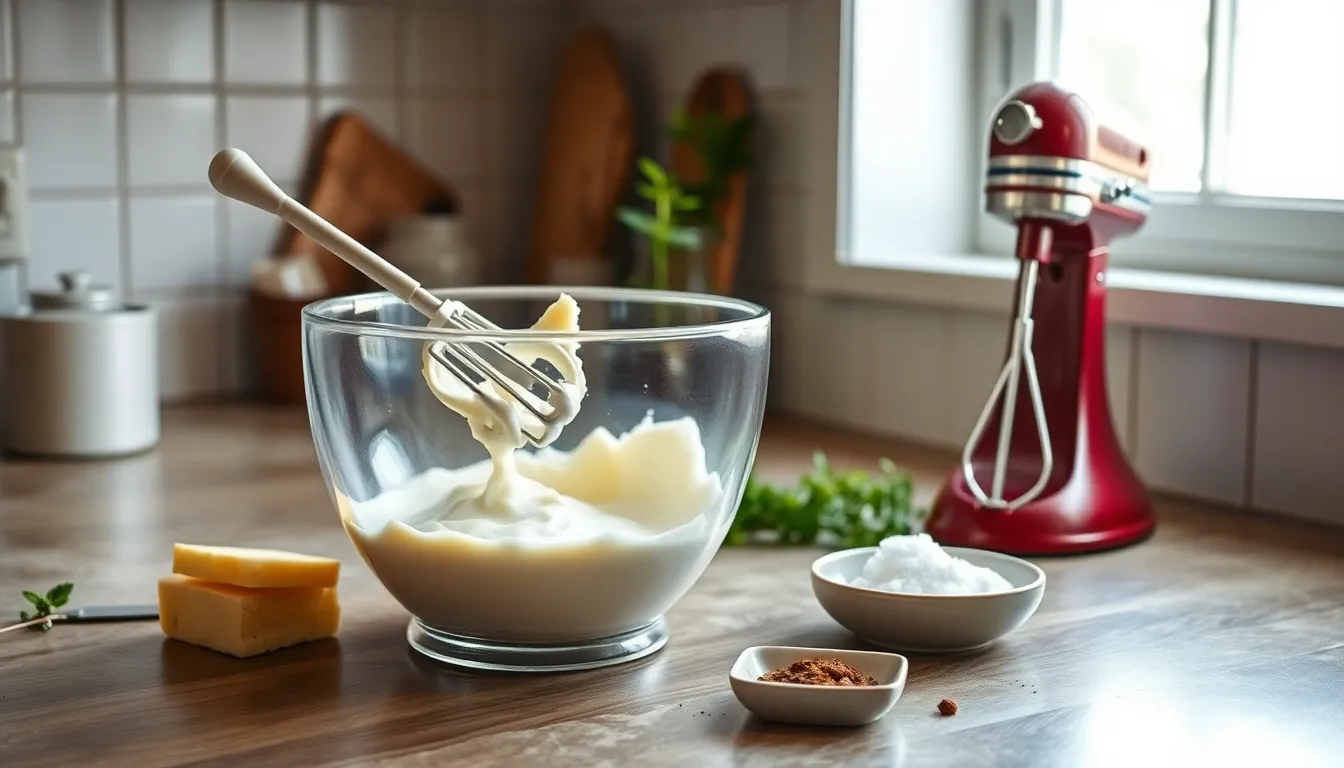Table of Contents
ToggleImagine standing in your kitchen, armed with a jug of whole milk and a dream of creamy, homemade butter. It sounds like a culinary adventure straight out of a rustic cookbook, doesn’t it? But can you really transform that luscious milk into golden butter? Spoiler alert: you can!
While many might think butter-making is reserved for the dairy elite, it’s actually a delightful DIY project anyone can tackle. With a bit of patience and a splash of enthusiasm, you’ll be slathering your fresh creation on toast before you know it. So, roll up those sleeves and get ready to impress your taste buds—and perhaps even your friends—with the magic of turning whole milk into buttery bliss.
Can You Make Butter From Whole Milk?
Making butter from whole milk involves more than just a straightforward process. Whole milk contains about 3.25% to 4% fat, insufficient for traditional butter-making. Instead, cream from whole milk serves as the primary ingredient. Cream has a fat content of at least 36%, which is ideal for producing butter.
Starting with whole milk, one can separate the cream through a process called cream rising. This method entails placing the milk in the refrigerator for 24 to 48 hours. After this time, the cream will rise to the top and can be skimmed off. Alternatively, a cream separator can expedite the process, yielding cream directly.
Once sufficient cream is collected, it needs to be churned. Churning transforms cream into butter. This process takes about 10 to 20 minutes of vigorous shaking or using a stand mixer. The cream will first turn into whipped cream, then eventually separate into butter and buttermilk.
Reductions in temperature can enhance the butter-making process. Chilling the cream before churning can help achieve better results. Temperature also affects the texture and flavor of the final product.
With patience, making butter from whole milk’s cream is achievable. The final product can vary in taste and texture based on the cream’s origin. Freshness and quality of the cream play a crucial role in the end flavor. Homemade butter provides unique characteristics not found in store-bought options, making it a rewarding endeavor.
The Process of Making Butter

Making butter from whole milk requires some essential steps. Readers must understand how whole milk differs from cream in fat content. Whole milk typically contains 3.25% to 4% fat, while cream consists of at least 36% fat. Consequently, achieving traditional butter’s texture and flavor requires more fat than whole milk offers.
Understanding Whole Milk
Whole milk serves as a base for homemade dairy products. It includes proteins and sugars which contribute to overall flavor. Fat content plays a crucial role in the butter-making process, making it vital to consider before starting. With a lower fat percentage, whole milk cannot produce butter directly. Instead, it offers a creamy base for separating cream, making it an essential ingredient in the butter-making journey.
Cream Separation Techniques
Several techniques exist for separating cream from whole milk. One common method involves allowing the milk to sit undisturbed in the refrigerator, where cream naturally rises to the top. Another option includes using a cream separator, a specialized device that efficiently separates fat from liquid. Employing these techniques allows individuals to collect enough cream for churning. A higher cream yield leads to a richer butter product, ensuring a more satisfying homemade experience.
Tools and Ingredients Needed
To make butter from whole milk, specific tools and ingredients contribute to the process. These essentials ensure a successful homemade butter experience.
Essential Kitchen Equipment
A mixing bowl serves as the primary vessel for the ingredients. A hand mixer or stand mixer provides the necessary power to churn the cream effectively. A fine mesh strainer or cheesecloth aids in separating the cream from the milk. A spatula helps in scraping down the sides of the bowl during mixing. Measuring cups allow for precise quantities of cream. Lastly, a refrigerator ensures proper cooling before churning.
Ingredients Required
Whole milk forms the base, though it contains lower fat content compared to cream. Cream, with a fat percentage of at least 36%, is crucial for achieving butter consistency. Salt adds flavor to enhance the final product. Optional flavoring agents, such as herbs or spices, allow for customization. Freshness significantly affects taste, thus choosing high-quality ingredients results in richer butter.
Step-by-Step Guide to Making Butter
Creating homemade butter is a straightforward process that requires minimal ingredients and tools. Following these steps leads to delicious, creamy butter.
Churning Techniques
Churning transforms cream into butter through agitating its fats. Various methods can accomplish this, from using a mixer to employing a traditional butter churn. Mixing by hand, while labor-intensive, offers a unique experience and control over texture. Electric mixers significantly reduce churning time, with about 10 to 20 minutes needed for transformation. It’s essential to stop when butter solids and buttermilk separate completely. Several techniques allow for customization; either gradual mixing or aggressive churning can affect the final consistency. Ensuring cream is chilled enhances results, creating a firmer butter product.
Flavoring Your Butter
Flavoring the butter opens up culinary creativity. Simple additions like salt provide basic seasoning and enhance the overall taste. Fresh herbs, such as chives or basil, infuse unique flavors, transforming butter into a gourmet spread. Spices, like garlic powder or smoked paprika, also create distinctive variants. Blending in honey or maple syrup introduces sweetness for desserts and breakfast dishes. Experimenting with different flavor combinations allows for personalized and enjoyable results. Freshness of added ingredients significantly influences taste; they should always be high-quality.
Common Challenges and Solutions
Making butter from whole milk presents several hurdles. One major challenge is the low fat content of whole milk, which ranges from 3.25% to 4%. Achieving sufficient cream for butter requires either patience or the right tools. Allowing whole milk to sit in the refrigerator for about 24 hours enables the cream to rise. Alternatively, using a cream separator offers a more efficient solution.
Churning the cream can also pose difficulties. After collecting enough cream, it often takes 10 to 20 minutes of vigorous mixing to achieve butter consistency. Stopping too early can lead to an undesirable texture. Using a stand mixer can reduce the churning time significantly, making the process easier.
A cooling tip helps when preparing the cream. Chilling the cream before churning leads to a firmer butter product. Keeping the temperature low enhances the texture and flavor, promoting a better outcome.
Another common obstacle involves flavoring the butter. While salt is a basic and effective additive for enhancement, some may prefer creative options like herbs or spices. Experimenting with different flavors can elevate the final product, but freshness must be a priority. High-quality, fresh ingredients substantially influence taste, providing a unique character to the butter.
Finally, storage can be a consideration after making butter. Keeping the freshly made butter in an airtight container in the refrigerator extends its shelf life. For longer preservation, freezing butter in proper portions ensures availability for future use.
Making butter from whole milk can be a rewarding experience that sparks creativity in the kitchen. While whole milk alone won’t yield traditional butter due to its lower fat content, the process of separating cream opens up a world of possibilities. With the right tools and techniques, anyone can enjoy the satisfaction of creating their own rich and flavorful butter.
The journey from cream to butter allows for personalization through various flavoring options. Embracing this culinary adventure not only enhances cooking skills but also leads to delicious results that can impress family and friends. Freshly made butter brings a unique taste that truly elevates any dish, making the effort worthwhile.




